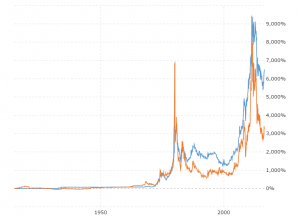Vienna Philharmonic Bullion Coins
Austria is a small European country that rarely makes it into the news. The last remaining part of what was once the large and important Austro-Hungarian Empire, this country does many to make it onto one list that is important to coin collectors – it rates third in the world for top-selling bullion coins. Many collectors of bullion stick to one country, such as American gold or silver eagles, but why not diversify your collection? The Vienna Philharmonic bullion coin series is a great place to start, and you will own a coin that is instantly recognizable and accepted for quality and reliability.
If Austria is known for one thing, it is music. The home of Mozart, Haydn, Schubert and Mahler, the only Austrian connection that comes close is delicious Sacher torte. So it is not surprising that when designing a bullion coin, they chose the famous Vienna Philharmonic Orchestra to feature on the coins. Since it was first introduced in 1989 all the coins have the same design, by the chief engraver of the Austrian Mint, Thomas Pesendorfer. The obverse shows the pipe organ in the Golden Hall of the Vienna Musikverein, the home of the Philharmonic, and one of the world’s finest concert halls. The reverse shows a variety of instruments, specifically a Vienna horn, a bassoon, a harp, and four violins around a cello. Only the year of issue is changed.
The coins are issued in gold, silver and platinum, with the issue each year regulated by demand. The one troy ounce gold coin is always a big seller, with a 99.99% purity. It was the original coin, first issued in 1989. The face value of those original coins was 200 Austrian schillings, but in 2002, when Austria adopted the euro, the face value was changed to €100. At first the only other gold coin was a half-ounce, but in 1991 a one-tenth ounce gold coin was added, and in 1994 a half-ounce coin. In 2014 a one-twenty-fifth ounce coin, with a face value of €4, was introduced as well. The one-ounce coin has consistently been a top seller, not only in Europe, but globally too.
In 2008 a silver bullion coin, weighing one ounce, with a face value of €1.50, and a 99.9% purity, was added to the series, and in 2016 the one- ounce platinum was introduced, with a face value of €100. All the coins show, beside the date, the weight and face value on the obverse. They are, naturally, in German, so the platinum coin shows UNZE PLATIN 999.5 on it. The other inscriptions on the obverse are, REPUELIK OSTERREICH, 100 EURO, and the date of issue. The reverse inscriptions are WEINER PHILHARMONICER, above the image of the musical instruments.
On the 15th anniversary of the Vienna Philharmonic, in 2004, the Austrian Mint created fifteen 1,000-ounce versions of the coin, with a face value of €100,000. Often called the “Big Phil”, it contains 1,000 troy ounces (31.103 kilograms) of pure gold. For the 20th anniversary a 20 troy ounce coin was released, and a little over 6,000 of those coins were minted.
For a collector looking to expand their bullion collection into something new, the Austrian Philharmonic is an obvious and secure choice.









Two comments: 1) the spelling REPUELIK OSTERREICH and WEINER PHILHARMONICER, are all wrong. The correct spelling is: REPUBLIK ÖSTERREICH, WIENER PHILHARMONIKER.
2) The Philharmonic gold coin is unique among all bullion gold coins as it displays on both sides of the coin musical instruments which are symbols of human culture. On other bullion coins, one finds symbols of state power and ideology (liberty, eagles, dead politicians, kings, queens etc) or symbols of nature like animals (kangaroo, wolf, rabbit, goat, deer etc) or plants like maple leaf, flowers etc. I prefer humans culture to any form of state ideology. For that reason, the philharmonic is my favorite gold bullion coin.